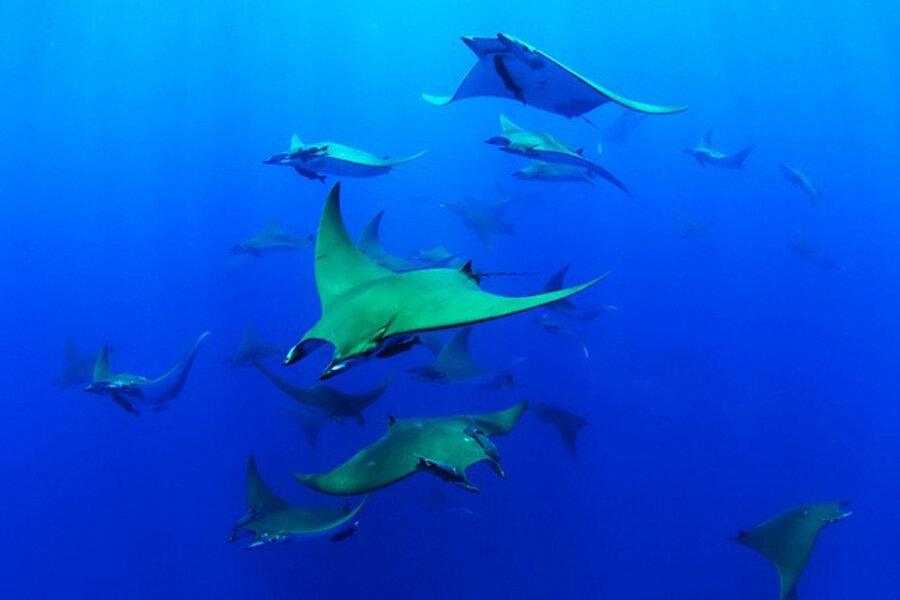Why do devil rays have a heat-exchanger under their brains? Scientists unravel mystery.
Loading...
The Chilean devil ray has always been considered a shallow-water swimmer, but new research shows that the species frequently dives to depths of more than 6,000 feet (1,800 meters), likely in search of food.
Prior to this research, marine biologists thought Chilean devil rays (Mobula tarapacana) did not descend below 3,280 feet (1,000 m). However, new satellite tracking data now shows that these rays are among the deepest-diving marine animals. Researchers think the rays spend most of their time in shallow water to warm themselves, and then dive down to extreme depths in search of small crustaceans and fish to eat.
"The fact that they were traveling so far horizontally was not necessarily surprising, but the diving behavior was very surprising," Simon Thorrold, a senior scientist at Woods Hole Oceanographic Institution in Woods Hole, Massachusetts, told Live Science. "What they're doing down there is the big unknown." [In Photos: The Wonders of the Deep Sea]
It's common for ocean predators to dive into the mesopelagic zone, a stretch of ocean water 656 to 3,280 feet (200 to 1,000 m) below the surface, to feast on squid and krill. But few predators make it deeper than the mesopelagic zone to the bathypelagic zone. The bathypelagic zone is a huge food resource, home to an estimated 10 billion tons of prey fish, but few ocean predators can withstand the extreme pressure, cold temperatures and low oxygen levels.
In deep ocean zones, the water can be as cold as 37 degrees Fahrenheit (3 degrees Celsius). Deep-diving ocean predators must maintain a higher brain temperature than the surrounding water, so they are equipped with a special organ called the rete mirabile. The organ functions as a heat-exchange system that warms the animal's brain and helps it function better in the extreme cold. The organ also helps the animal see better when it's hunting in deep, dark waters.
Scientists were puzzled as to why Chilean devil rays, believed to be surface dwellers, had the organ. Researchers originally suggested that the rete mirabile helped to cool the brains of the rays living in the warm and shallow tropical waters.
Researchers tagged 15 Chilean devil rays off the coast of northern Africa and tracked them for nine months. The satellite data revealed that the rays can reach depths of around 6,560 feet (2,000 m), where temperatures can drop as low as 37 degrees Fahrenheit.
The rays typically hover just a few feet below the surface for about an hour, before descending deep into the cold water. Most of the dives followed the same pattern. The rays would first dive to the maximum depth, and then ascend slowly in a stair-step pattern. The researchers think this stair-step pattern allows the rays to hunt for prey that usually travel in layered clumps in the bathypelagic zone. The dives lasted between 60 and 90 minutes, and the rays usually only made one dive in a 24-hour period.
Thorrold and the researchers think the devil rays likely dive for food, because the rays exhibit the same quick-descent and slower-ascent diving behavior that other ocean predators (such as sharks) use when hunting. However, more research is needed to confirm this idea, the researchers said.
Most of the dives happened during the day. This is likely because the rays can warm up more during the day and because prey are easier to catch during the day, when they travel in clumps, rather than at night, when they are more spread out, Thorrold said.
This is the only species of Mobula rays that researchers have observed diving. The scientists hope that more research into these marine creatures' behavior will reveal insights about the relationship between marine animals and different ocean zones.
The details of the discovery are published today (July 1) in the journal Nature Communications.
Follow Kelly Dickerson on Twitter. Follow us @livescience, Facebook & Google+. Original article onLive Science.
- Marine Marvels: Spectacular Photos of Sea Creatures
- The 12 Weirdest Animal Discoveries
- Dangers in the Deep: 10 Scariest Sea Creatures
Copyright 2014 LiveScience, a TechMediaNetwork company. All rights reserved. This material may not be published, broadcast, rewritten or redistributed.







